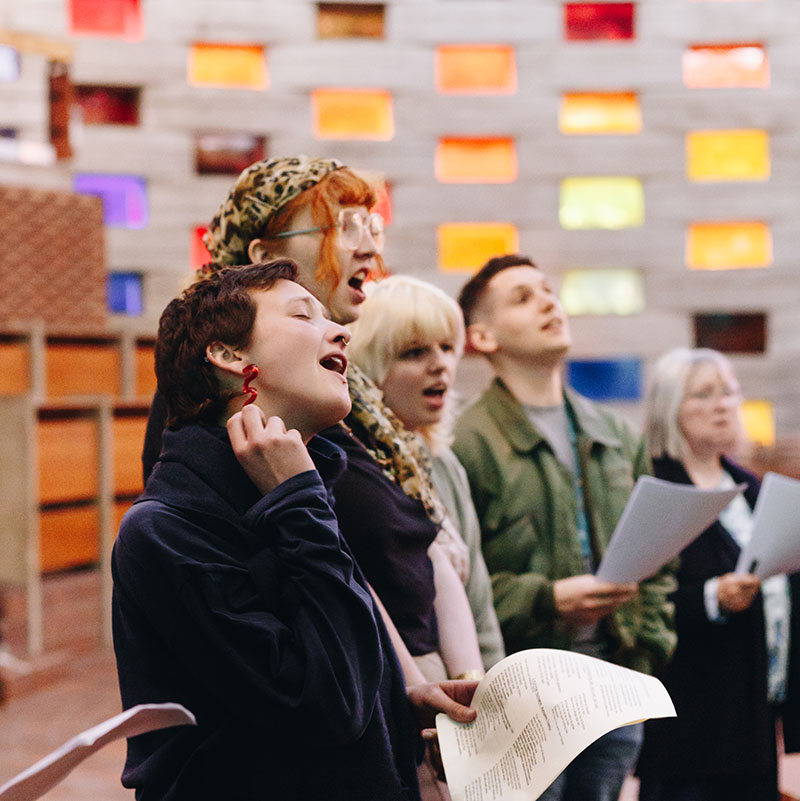Guest blog post from Dr Sam Solomon (University of Sussex)
Three Yiddish singing workshops led by Polina Shepherd were held at the University of Sussex between April and June 2022 in collaboration with the University of Sussex Students’ Union and the university’s Meeting House and Chaplaincy. Participants were invited to join the Brighton and Hove Yiddish Choir performance in Refugee Week 2022.
Dr Samuel Solomon came to the first two workshops and, along with Polina Shepherd, introduced the participants to Yiddish and the songs they were to learn. These are an edited version of his notes.
What is Yiddish?
The language dates to the Middle Ages and has various dialects developed during the long swathe of its history; its origins are widely debated. The songs in this workshop were created in the Yiddish of the 18th, 19th and 20th centuries in eastern Europe and its diaspora.
The lexicon of the language is largely from Germanic languages, although there are significant Hebraic, Slavic, Romance and Aramaic lexical elements as well. Yiddish is written in the Hebrew alphabet. The grammar varies based on the dialect. It is generally thought to be derived from Middle-High German, although some people have argued that the grammar is more Slavic.
Yiddish was the everyday language of the street, home and workplace for many Ashkenazi (eastern European) Jews, especially working-class Jews in the Pale of Settlement in the Russian Empire. The Pale of Settlement was the area in a region where Jews were allowed to settle permanently – although not without danger. These areas were often not in the wealthier cities, where at various times there were quotas for the numbers of Jewish residents and limitations on their education.
Yiddish songs
The workshop songs were Mayn Rue-Plats (My Resting Place) by Morris Rosenfeld and Di Tsukunft (The Future) by Morris W(V)inchevsky.
Morris Rosenfeld (1862–1923) came from what is now Poland, near the Lithuanian border. Morris Winchevsky (1856–1932) was born near Kovna (now Kaunas in Lithuania).
Both places were part of the Pale of Settlement, places with significant Jewish cultural life conducted in Yiddish and other languages. Both writers were committed socialists in the late 19th century, and this was very typical. Like many other revolutionary Jewish people, they left eastern Europe in the late 19th century for economic and political reasons; both lived in London at various points and ended up in New York, USA in the late 19th /early 20th century.
Rosenfeld and Winchevsky are considered part of the group of ‘proletarian poets’, or ‘sweatshop poets’, alongside Joseph Bovshover and Dovid Edelshtot. Apart from Winchevsky, they all laboured in the factories and workshops where so many Jewish and other working-class immigrants worked, including large numbers of women. Conditions were exploitative and often extremely dangerous. Rosenfeld was a textile worker and tailor at various points.
Both poets were deeply involved in a range of Yiddish-language socialist and workers’ organisations in the USA and published their work in many of the widely circulating radical Yiddish periodicals of the time – some associated with particular political organisations and parties, others not.
They wrote poems with different aims. Rosenfeld’s work is often at human, personal scale, showing people’s pains and hopes. His well-known poem Mayn Yingele (My Little Boy) describes how a young worker becomes estranged from his family owing to lengthy working hours in a sweatshop. Although Rosenfeld’s work is less likely to involve rousing calls to arms than Winchevsky’s, we can see that a poem like Mayn Rue Plats has a paradoxical utopian impulse. It’s contradictory and fascinating.
The ‘proletarian poets’ would come to be dismissed as ‘unliterary’ and overly dogmatic by some of the modernist writers who followed on from them. But so many of the poems by these writers also became songs, both at the time they were written (Mayn Rue-Plats was written as a song) and after. They were performed in the 20th century and more recently, by Yiddish musicians and arrangers such as Polina Shepherd. These songs form part of the 20th– and 21st-century life of Yiddish and a culture of aspiration for a fair, just world. They imagine common human thriving without borders and cruel nationalisms, even if only in death.
Dr Samuel Solomon is a Senior Lecturer at the University of Sussex, specialising in contemporary literature, especially as it relates to radical social movements. With Faith Jones and Jennifer Kronovet he co-translated The Acrobat: Selected Poems of Celia Dropkin (Tebot Bach, 2014) from Yiddish to English.
